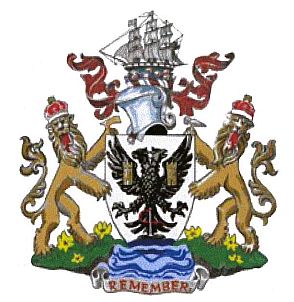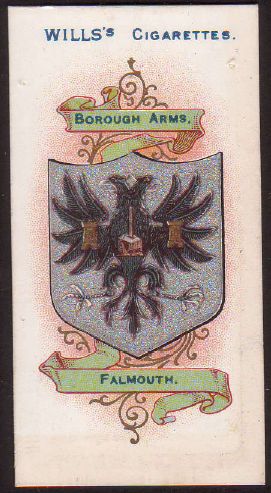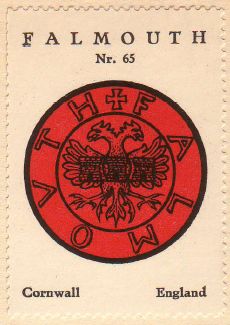Falmouth
| Heraldry of the World |
| British heraldry portal Civic heraldry of the United Kingdom |
|
FALMOUTH
Incorporated into : 1974 Carrick DC (2009 Cornwall Unitary Authority)
Official blazon
Arms : Argent a double-headed Eagle displayed Sable each wing charged with a Tower Or in base issuant from Water barry wavy proper a Rock also Sable thereon surmounting the tail of the Eagle a Staff also proper flying therefrom a Pennon Gules.
Crest: On a Wreath of the Colours out of a Chaplet of Oak proper fructed Or a representation of the ancient Falmouth Packet Boat in full sail proper.
Supporters : On either side a Lion guardant Or crowned with a Royal Crown of the seventeenth century proper the dexter holding in the interior forepaw an Adze and the sinister in the like paw a Pin Maul also proper.
Motto: 'REMEMBER'
Origin/meaning
The arms were officially granted on March 7, 1961 and are now used by the town council.
The arms are based on the previous seal, which had been used until the granting of the town’s own arms in 1961 – 300 years after Falmouth had been granted its charter by King Charles II in 1661. The eagle is from the arms of the Killigrew family, which bore a black eagle on silver within a bordure of Cornish bezants on black. The family held the Manor of Arwenack of which the hamlets of Smithick and Pennycomequick formed part. The two gold towers represent the defences of the estuary or Carrick Roads – the forts at Pendennis and St Mawes, built in Tudor times to safeguard the harbour. The rock and pole, with red pennant flying, stand for the Black Rock, on which former rectors of Falmouth were allowed by Act of Parliament to keep a pole flying a red flag to warn ships of the danger. The rectors, for this service, received sixpence for every decked ship that came into port. The water at the base stands for the River Fal and the sea.
The chaplet of oak commemorates the time when King Charles I hid in an oak tree after the defeat of his forces at the Battle of Worcester during the English Civil War in 1651. The Falmouth Packet ship, resplendent in full sail, recalls the mail packet service which was in operation between 1688 and 1852.
The two lions are adorned with 17th century Royal crowns are a reference to King Charles II’s gift of charter. The adze and pin maul, which are shipwright’s tools, represent the local shipping industry.
The motto “Remember” was the last word spoken by King Charles I at his execution to the Bishop Juxon. This word to Falmouth means to remember the English Civil War, the siege of Pendennis, the Restoration, the Charter of 1661 and the building of the parish church – dedicated to King Charles the Martyr.
| The arms on a Wills's cigarette card, 1906 |
The arms in the Coffee Hag albums +/- 1935 |
Contact and Support
Partners:
Your logo here ?
Contact us
© since 1995, Heraldry of the World, Ralf Hartemink 
Index of the site
Literature : Image and information from the Falmouth Town Council















